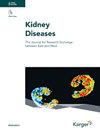A Klotho-based Machine Learning Model for Prediction of both Kidney and Cardiovascular Outcomes in Chronic Kidney Disease
IF 3.2
4区 医学
Q1 UROLOGY & NEPHROLOGY
引用次数: 0
Abstract
Background: This study aimed to develop and validate a machine learning (ML) model based on serum Klotho for predicting end-stage kidney disease (ESKD) and cardiovascular disease (CVD) in patients with chronic kidney disease (CKD). Methods: Five different ML models were trained to predict the risk of ESKD and CVD at three different time points (3, 5, and 8-year) using a cohort of 400 non-dialysis CKD patients. The dataset was divided into a training set (70%) and an internal validation set (30%). These models were informed by data comprising 47 clinical features, including serum Klotho. The best-performing model was selected and used to identify risk factors for each outcome. Model performance was assessed using various metrics. Results: The findings showed that the Lasso regression model had the highest accuracy (C-index=0.71) in predicting ESKD. The features mainly included in this model were estimated glomerular filtration rate (eGFR), 24-hour urinary microalbumin, serum albumin, phosphate, parathyroid hormone, and serum Klotho, which achieved the highest area under the curve (AUC) of 0.930 (95% CI: 0.897-0.962). In addition, for the CVD risk prediction, the Random Survival Forest (RSF) model with the highest accuracy (C-index=0.66) was selected and achieved the highest AUC of 0.782 (95% CI: 0.633-0.930). The features mainly included in this model were age, history of primary hypertension, calcium, tumor necrosis factor-alpha, and serum Klotho. Conclusion: We successfully developed and validated Klotho-based ML risk prediction models for CVD and ESKD in CKD patients with good performance, indicating their high clinical utility.基于 Klotho 的机器学习模型用于预测慢性肾脏病患者的肾脏和心血管预后
背景:本研究旨在开发和验证一种基于血清Klotho的机器学习(ML)模型,用于预测慢性肾脏病(CKD)患者的终末期肾脏病(ESKD)和心血管疾病(CVD):使用 400 名非透析 CKD 患者队列训练了五个不同的 ML 模型,以预测三个不同时间点(3 年、5 年和 8 年)的 ESKD 和 CVD 风险。数据集分为训练集(70%)和内部验证集(30%)。这些模型参考了包括血清 Klotho 在内的 47 个临床特征数据。筛选出表现最佳的模型,用于确定每种结果的风险因素。使用各种指标对模型性能进行评估:研究结果表明,Lasso 回归模型预测 ESKD 的准确率最高(C 指数=0.71)。该模型的主要特征包括估计肾小球滤过率(eGFR)、24 小时尿微量白蛋白、血清白蛋白、磷酸盐、甲状旁腺激素和血清 Klotho,其曲线下面积(AUC)最高,为 0.930(95% CI:0.897-0.962)。此外,在心血管疾病风险预测方面,随机生存森林(RSF)模型的准确度最高(C-index=0.66),AUC 最高,达到 0.782(95% CI:0.633-0.930)。该模型的主要特征包括年龄、原发性高血压病史、血钙、肿瘤坏死因子-α和血清 Klotho:我们成功开发并验证了基于 Klotho 的 CKD 患者心血管疾病和 ESKD 的 ML 风险预测模型,该模型性能良好,表明其具有很高的临床实用性。
本文章由计算机程序翻译,如有差异,请以英文原文为准。
求助全文
约1分钟内获得全文
求助全文
来源期刊

Kidney Diseases
UROLOGY & NEPHROLOGY-
CiteScore
6.00
自引率
2.70%
发文量
33
审稿时长
27 weeks
期刊介绍:
''Kidney Diseases'' aims to provide a platform for Asian and Western research to further and support communication and exchange of knowledge. Review articles cover the most recent clinical and basic science relevant to the entire field of nephrological disorders, including glomerular diseases, acute and chronic kidney injury, tubulo-interstitial disease, hypertension and metabolism-related disorders, end-stage renal disease, and genetic kidney disease. Special articles are prepared by two authors, one from East and one from West, which compare genetics, epidemiology, diagnosis methods, and treatment options of a disease.
 求助内容:
求助内容: 应助结果提醒方式:
应助结果提醒方式:


